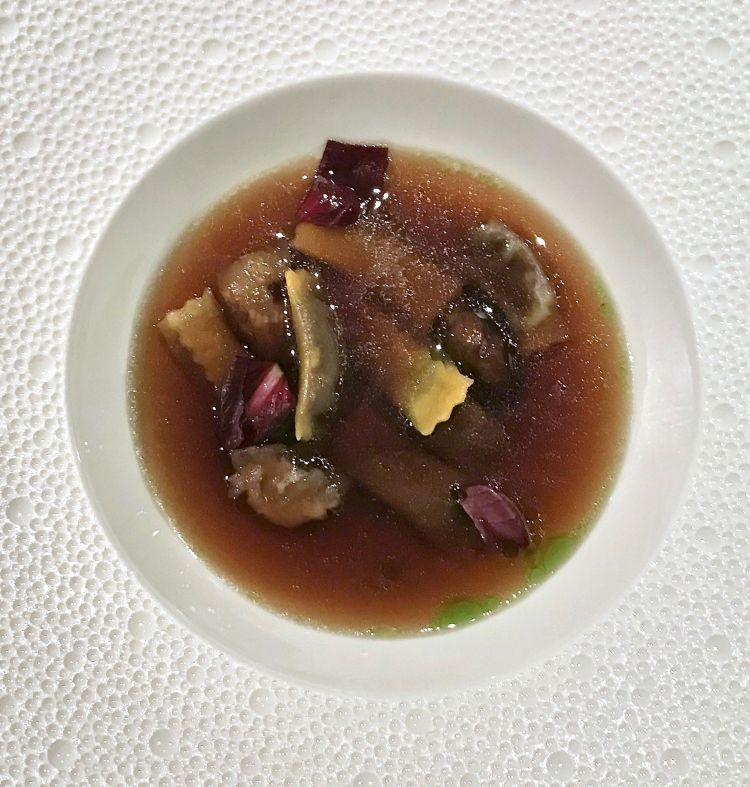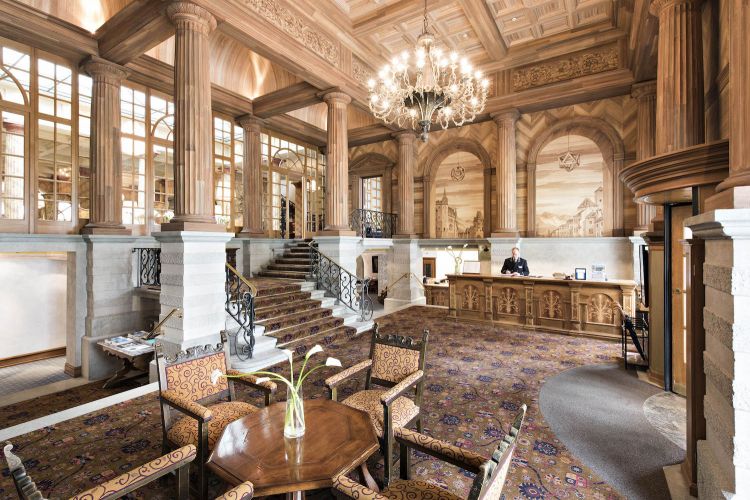Wild boar consommé, ravioli with red cabbage, chestnuts, foie gras, red endive: no, this is certainly not a Mauro Colagreco dish. He’s a singer of Mediterranean biodiversity, fascinated by waves and vegetable gardens, the creator of a cuisine whose points of reference are in the tides, in the movement of the stars, inspired by the relationship between sky and earth following the biodynamic calendar, studying the secret rhythms of seeds, leaves, roots... (read here)
Instead, never mind: it is indeed a Mauro Colagreco dish.
To (re)find him, don't point your navigator to Menton, just a few metres from the border between Italy and France, and Mirazur; nor to any of the many restaurants that the Italo-Argentinian chef has opened on the Côte d'Azur. Instead, take State Road 36, which runs along the eastern branch of Lake Como, right on the edge of Valtellina, enter Valchiavenna, cross into Switzerland via the Dogana border, nomen omen, then tackle the steep hairpin bends that from Bregaglia - in the Canton of Grisons - eat up almost a thousand metres of elevation gain to reach the Upper Engadine, up the course of the Inn River, gradually leaving behind the lakes of Silvaplana and Champfèr, until you reach another body of water - these days frozen over – named after the town it bathes: San Maurizio, or rather Sankt Moritz.

Wild boar consommé, red cabbage ravioli, chestnuts, foie gras, red endive
Two short-circuits were happily resolved during our recent trip to the famous Swiss luxury resort. In order to defuse the first, we needed to understand what
Mauro Colagreco was doing there with his restaurant
The K, one Michelin star since February 2021, i.e. little more than a month after its debut, a reward perhaps for the chef’s well-deserved credibility but then in fact over-deserved in the field, as our palates can confirm. This short-circuit is answered in full by a dish such as
Consommé of wild boar, ravioli with red cabbage, chestnuts, foie gras and red endive, conceived - mind you - well before his debut with
The K, but which here finds its unexpected territory of choice. In other words,
Colagreco's greatness is confirmed in our eyes by the full adherence of his style to a terroir that is completely different from his own; at
The K, one tastes a cuisine that is fully
Colagrechian - pardon the adventurous neologism - and yet completely immersed in the valley atmosphere, in the clear and icy air that pervades the southern slopes of the Albula Alps, right below Piz Nair, with its 3,056 metres.

Trout, its roe, crayfish, butter sudachi sauce

Guinea fowl, white truffle, cardoncelli and Albufera sauce
After all, it only takes a few touches, by the looks of the menu: the
Peter fish. butter sudachi sauce and trout roe, which we had enjoyed at
Mirazur, is transformed into
Trout, its roe, crayfish, butter sudachi sauce, so from a marine treat, it is immediately projected into a mountain setting; the same goes for Guinea fowl, saffron (guinea fowl breast seasoned with a saffron sauce from Sospel, a village in the Alpes-Maritimes, then mussels, lemon gel and chopped mussels and sun-dried tomatoes), which here changes nature and becomes
Guinea fowl, white truffle, cardoncelli mushrooms and Albufera sauce; the
surrounding woods recall the chestnuts which, in thin layers, cover the
white truffle Churros with a
trompe-l'oeil effect, the third appetiser after a leap between the Mediterranean and the East (
Crispy tapioca, tuna tartare, seaweed, yuzu and ponzu gel) and the ode (
Pumpkin pie, pumpkin cream and its seeds) to an ingredient that recalls an old anecdote,
Mauro on a shopping trip to a Lombard fruit and vegetable wholesaler, sees a wonderful pumpkin and solves a problem, '
on ira à faire un plat avec ça!', we're going to make a dish with just this.

Pumpkin pie, pumpkin cream and its seeds

Crispy tapioca, tuna tartare, seaweed, yuzu and ponzu gel
Then, of course, there are also some
Mirazur classics at
The K's, such as
Hibiscus and beetroot (hibiscus powder, beetroot petals, hibiscus beetroot vinaigrette cooked in a salt crust), an excellent harmony turned into a dish, or the sweet long seller
Naranjo en flor. And lobster, which is never missing and here takes on a different guise:
Lobster with butter, rutabaga, Verjus sauce (Verjus sauce is similar to agresto, i.e. an acidic condiment obtained by cooking a must of unripe grapes. Rutabaga is a Nordic winter vegetable similar to turnip). In short:
Colagreco has a mountain approach while being true to himself. Very interesting.

Buttered lobster, rutabaga, Verjus sauce
But let us pick up the threads of the initial discourse. "There are two happily resolved short-circuits..." etc., we wrote a few lines ago. One has therefore been solved. And the other?
The other is connected to the place where The K is housed: a hotel, but not just any hotel. It is both splendid and alienating because - here, in the Upper Engadine - practically everyone speaks Italian, or rather they are Italian: the staff seems to be equally divided between those from nearby Valtellina and Valchiavenna, and the others from the south of Italy. Thus the language of "yes" dominates among the dining room staff; it is also the dominant language in the exchange of orders that can be heard from the central kitchen, with its sixty or so members led by executive chef Mauro Taufer, from Feltre (Belluno) in the Veneto region. Born in 1975, his motto is: "Classic cuisine is the basis for creativity".

Colagreco with Mauro Taufer. Photo Thomas Buchwalder
It is a sort of
quid pro quo: the great art of Italian hospitality shines brightly, its empathy warming the climate of Sankt Moritz, which is actually not very cold these days, the lowest temperature being just below zero; and in turn it is honoured and dignified because it dominates unchallengedly an iconic structure: the
Kulm Hotel. Not only an establishment of the finest hôtellerie, like others nearby, but the historical cradle of Sankt Moritz as we know it.

Overview from above the lake, the Kulm is on the right
Step back 168 years. Twelve spartan rooms, made of wood: these were the rooms of the old
Faller boarding house, whose management was taken over in 1855 by a viscous fellow, Herr
Johannes Badrutt, then not yet 36 years old, the son of another
Johannes, a master builder and hardware merchant in nearby Samedan. Three years later, they went on to buy the property for 28,500 francs and renamed
Faller with the Engadiner name
Kulm, 'Engadine hill', from the Latin
culmen, to emphasise its strategic position at the highest point overlooking the lake. A minor event that would certainly change the history of Sankt Moritz and perhaps also that of winter tourism in general.

The Kulm Hotel in its early days and its founder, Johannes Badrutt. The original structure, with its typical double entrance staircase, still exists, in the south-west wing of the hotel
The episode is well known: the hotel soon became popular for spa and art holidays during the summer, particularly among the British, who made up 75 per cent of the guests. For
Badrutt, however, this was not enough. It was September 1864 when the last British guests were preparing to return home, this was the custom, they would not see each other again until late spring because no one seemed willing to spend a holiday in the snow. The boss then made a bet with four of them, with whom he was particularly familiar: 'Come in three months, in December. Here you can sit in your shirtsleeves on the terrace even in the winter sun,' he promised to reimburse all expenses if they were not satisfied at the end of their stay. They accepted the challenge, returned to the
Kulm Hotel and stayed there until spring, before returning home enthusiastic and tanned to tell of their winter spent on skates, sledging or strolling, under blue skies full of light (the story is perhaps, a legend. For sure there was a young Englishman,
Arthur Edward Vansittart Strettell, whose father was a regular summer guest in Sankt Moritz from 1860.
Arthur Edward suffered from tuberculosis. Hoping that the mountain air of the Engadin would help him, he spent a whole year in the Engadin from July 1866 to June 1867. It was therefore probably the
Strettells who then spread the idea of winter tourism among their friends and acquaintances).

The sumptuous entrance with concierge
The
Kulm thus became the first hotel in the country to be open in winter, triggering the development of Sankt Moritz as a sports and holiday resort even (if not especially) in the cold months. It was also the first Swiss hotel, in 1878, to have electricity installed; from here, at the end of the century, the first expeditions to the glaciers of the Engadin began (for the ladies: sleigh rides on the frozen lake); from here, thanks to guests from England, sports such as curling, of Scottish origin, spread, with the first playing field on the continent. And some sports were even born at
Kulm, such as bobsleigh and skeleton (this is how it went: English guests at
Kulm's 'winter version' were always looking for new distractions. At the beginning of the 1870s, some of them, particularly intrepid, took to adapting the boys' sledges for recreational purposes. This created quite a few problems: they ended up colliding with pedestrians in icy alleys! They first solved the problem by fitting a steering system underneath the sleds, a sort of prototype for modern bobsleighs, in order to be able to steer their vehicles better.
Badrutt found the solution by having the Cresta Run built in 1885, now the 'temple' of skeleton, a 1,214-metre-long natural ice rink, outside the town, in the
Kulm Park that stretched from St. Moritz to Celerina. It is no coincidence that it later hosted delegations of participants in the 2nd and 5th Winter Olympics, in 1928 and 1948).

Argentinean Paloma Boitier is the chef de cuisine of Colagreco at The K
Today the
Kulm Hotel - extended by the descendants of
Johannes Badrutt and renovated by the current owners, the
Niarchos family of Greek shipowners - is a charming jewel with 164 rooms and suites. And plenty of restaurants: in addition to the gourmet restaurant
The K by Mauro Colagreco and
Mauro Taufer's
Grand Restaurant, of which we have already written, there is also an Italian trattoria-pizzeria,
The Pizzeria (we tasted fine pizza, decent sarde in saor and baccalà mantecato), a Nikkei cuisine proposal (it's called
Sunny Bar but no, it didn't convince us), the
Kulm Country Club only a few dozen metres away and with good Italian-Mediterranean cuisine mixed with international influences with chef
Daniel Müller, plus the
Chesa al Parc at the entrance to the Kulm Park (Tuesdays: Venetian liver. Thursday: boiled meat) and the
Bob Restaurant at the start of the St. Moritz-Celerina piste, with Sicilian chef
Marco D'Agati. Because, round and round: luxury tourism, in Sankt Moritz, also wants to eat Italian.
The K by Mauro Colagreco at the Kulm Hotel
Via Veglia 18, Sankt Moritz (Switzerland)
tel. +41 81 8368203
website
open daily, only for dinner
tasting menu at 220 Swiss francs
Translated into English by Slawka G. Scarso